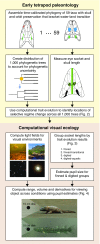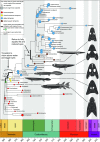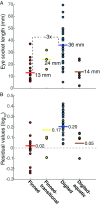Massive increase in visual range preceded the origin of terrestrial vertebrates
- PMID: 28270619
- PMCID: PMC5373340
- DOI: 10.1073/pnas.1615563114
Massive increase in visual range preceded the origin of terrestrial vertebrates
Abstract
The evolution of terrestrial vertebrates, starting around 385 million years ago, is an iconic moment in evolution that brings to mind images of fish transforming into four-legged animals. Here, we show that this radical change in body shape was preceded by an equally dramatic change in sensory abilities akin to transitioning from seeing over short distances in a dense fog to seeing over long distances on a clear day. Measurements of eye sockets and simulations of their evolution show that eyes nearly tripled in size just before vertebrates began living on land. Computational simulations of these animal's visual ecology show that for viewing objects through water, the increase in eye size provided a negligible increase in performance. However, when viewing objects through air, the increase in eye size provided a large increase in performance. The jump in eye size was, therefore, unlikely to have arisen for seeing through water and instead points to an unexpected hybrid of seeing through air while still primarily inhabiting water. Our results and several anatomical innovations arising at the same time suggest lifestyle similarity to crocodiles. The consequent combination of the increase in eye size and vision through air would have conferred a 1 million-fold increase in the amount of space within which objects could be seen. The "buena vista" hypothesis that our data suggest is that seeing opportunities from afar played a role in the subsequent evolution of fully terrestrial limbs as well as the emergence of elaborated action sequences through planning circuits in the nervous system.
Keywords: fish–tetrapod transition; prospective cognition; terrestriality; vision; visual ecology.
Conflict of interest statement
The authors declare no conflict of interest.
Figures





Comment in
-
Evolution: An Irresistibly Clear View of Land.Curr Biol. 2017 Jul 24;27(14):R715-R717. doi: 10.1016/j.cub.2017.05.082. Curr Biol. 2017. PMID: 28743021
References
-
- Felsenstein J. Phylogenies and the comparative method. Am Nat. 1985;125(1):1–15.
-
- Garland T, Ives AR. Using the past to predict the present: Confidence intervals for regression equations in phylogenetic comparative methods. Am Nat. 2000;155(3):346–364. - PubMed
-
- Hansen TF. Stabilizing selection and the comparative analysis of adaptation. Evolution. 1997;51(5):1341–1351. - PubMed
-
- Butler MA, King AA. Phylogenetic comparative analysis: A modeling approach for adaptive evolution. Am Nat. 2004;164(6):683–695. - PubMed
-
- Uyeda JC, Harmon LJ. A novel Bayesian method for inferring and interpreting the dynamics of adaptive landscapes from phylogenetic comparative data. Syst Biol. 2014;63(6):902–918. - PubMed
Publication types
MeSH terms
LinkOut - more resources
Full Text Sources
Other Literature Sources
Research Materials

